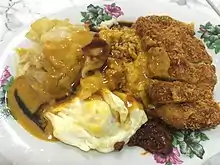Hainanese curry rice
Hainanese curry rice is a Singaporean dish consisting of steamed white rice smothered in a mess of curries and gravy, characteristically accompanied by curry chicken, pork chop, chap chye (braised cabbage) and kong bak (braised pork). It originates in Singaporean cuisine and is not thought of as part of the cuisine of Hainan, China.[1]
 Hainanese curry rice in Singapore | |
| Course | Main course |
|---|---|
| Place of origin | Singapore |
| Created by | Chinese Singaporeans |
| Serving temperature | Hot |
| Main ingredients | Steamed white rice smothered in a mess of curries and braised gravy |
History
Hainanese curry rice developed during British colonial rule in Singapore. It was started by Hainanese living in Singapore, who were often employed by the British as well as the wealthy Peranakans (Straits-Chinese) as chefs in their homes.[2] Pork chop was adapted from British cuisine and the rest of the ingredients, such as curry chicken, babi pongteh and chap chye, were from Peranakan cuisine. These were adapted for Hainanese curry rice. Loo's, one of the most well-known and popular Hainanese curry rice vendors in Singapore, started operations in 1946 and is situated opposite Tiong Bahru Market.[3]
Description
Rice
Traditionally, steamed white rice forms the base of this dish. In recent years, some outlets, for example Jin Soon Fa Curry Rice, offer brown rice as an option.[4]
Curry
The curry is milder and thicker than its South Asian variant.[5]
See also
References
- Chen, Evelyn (14 April 2011). "Singapore hawker hunting with food blogger Leslie Tay". CNN. Retrieved 2016-02-01.
- "The story of No Name Hainanese Curry Rice". The Straits Times. Archived from the original on 2016-04-09. Retrieved 2016-02-01.
- "Loo Hainanese Curry Rice: A legend still going strong after 70 years". The Malay Mail Online. Retrieved 2016-02-01.
- Ng, Sean (2017-10-19). "Feel The Fury With Singapore's 13 Best Hainanese Curry Rice". Miss Tam Chiak. Retrieved 2020-07-10.
- hermes (2016-07-24). "Hai Nan Hometown Curry adds spice to Ghim Moh Market & Food Centre". The Straits Times. Retrieved 2020-07-10.